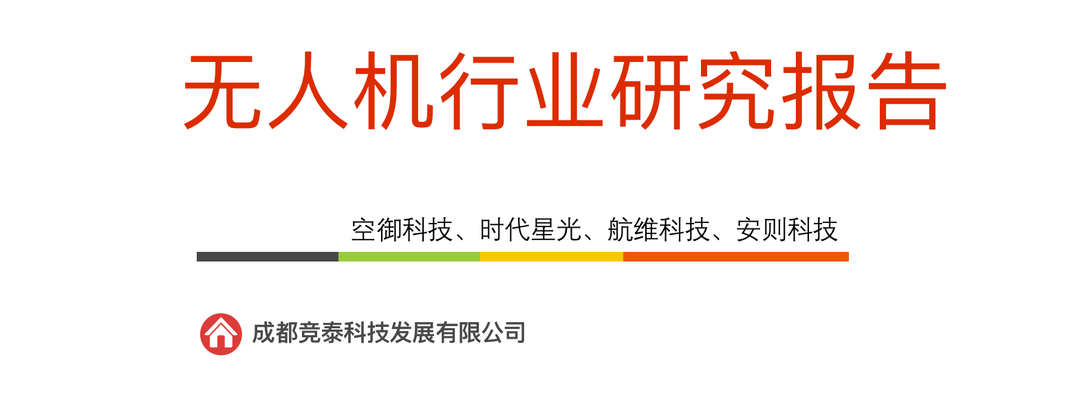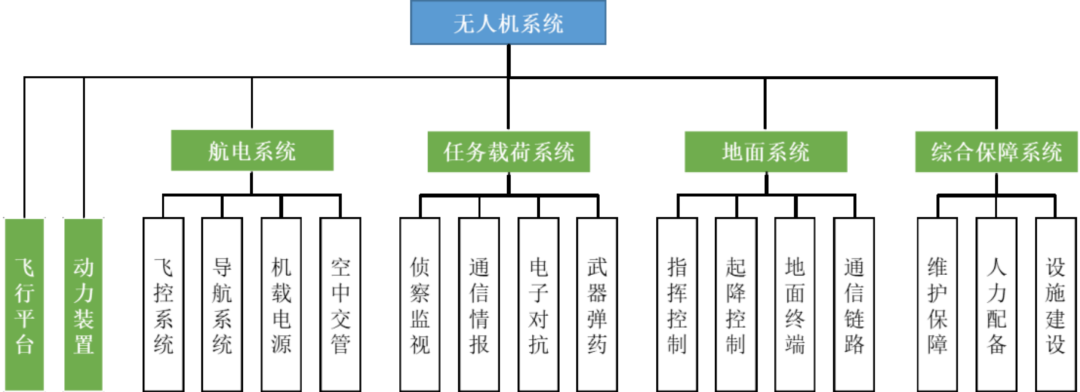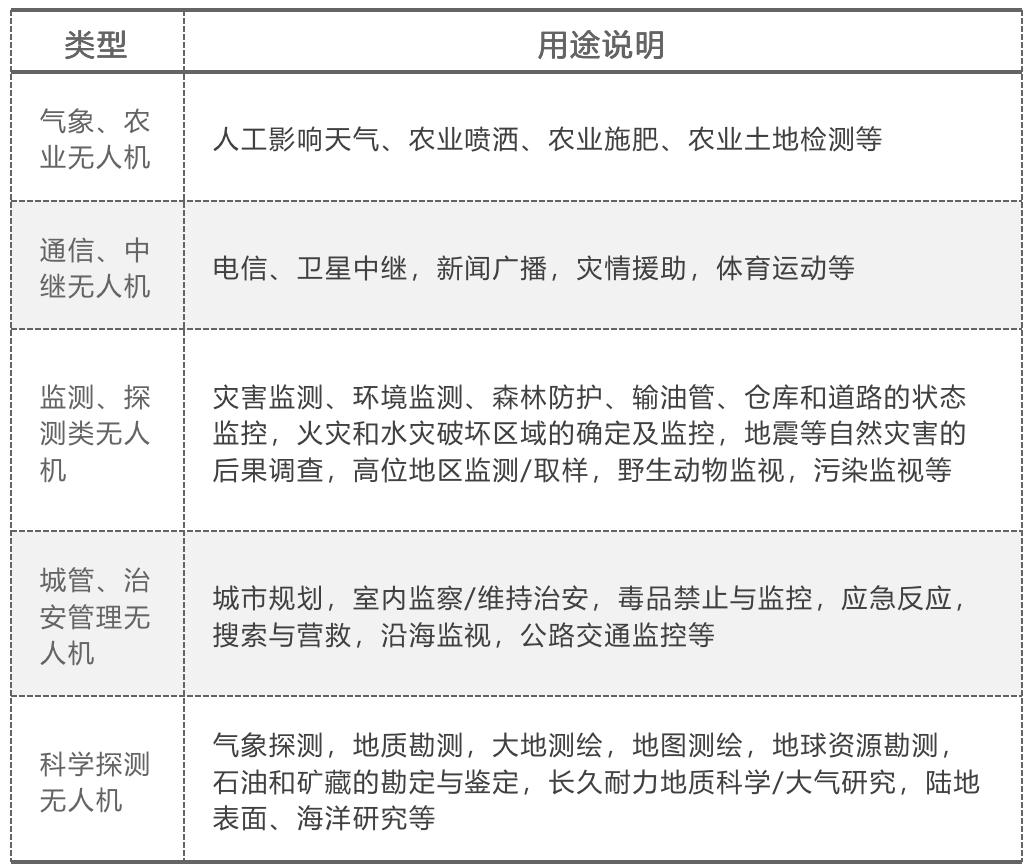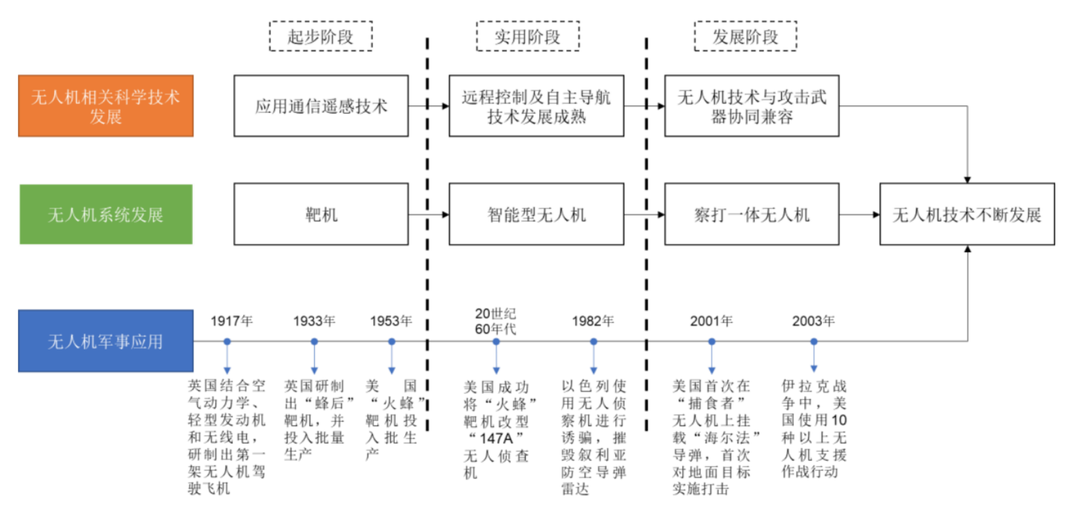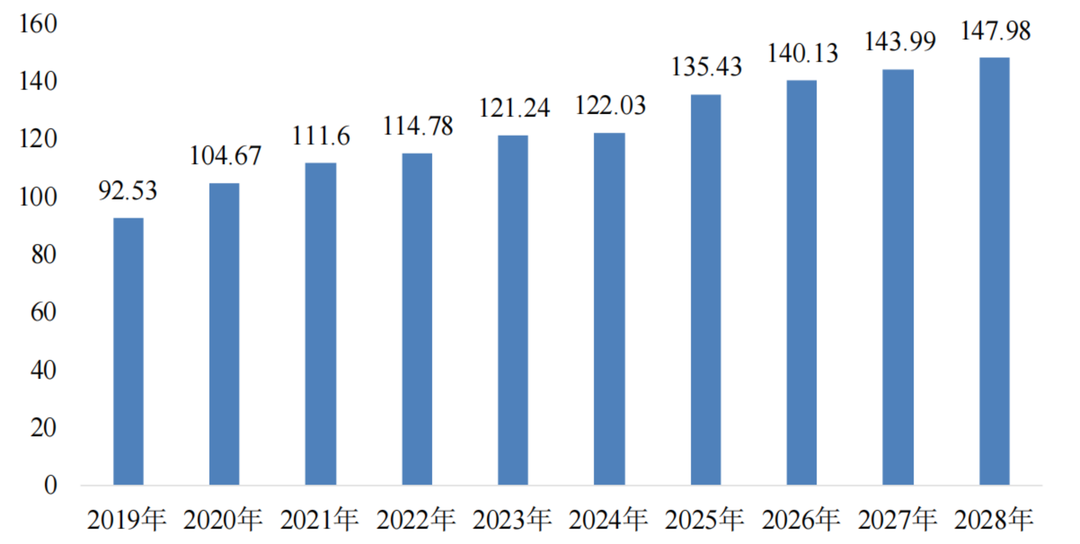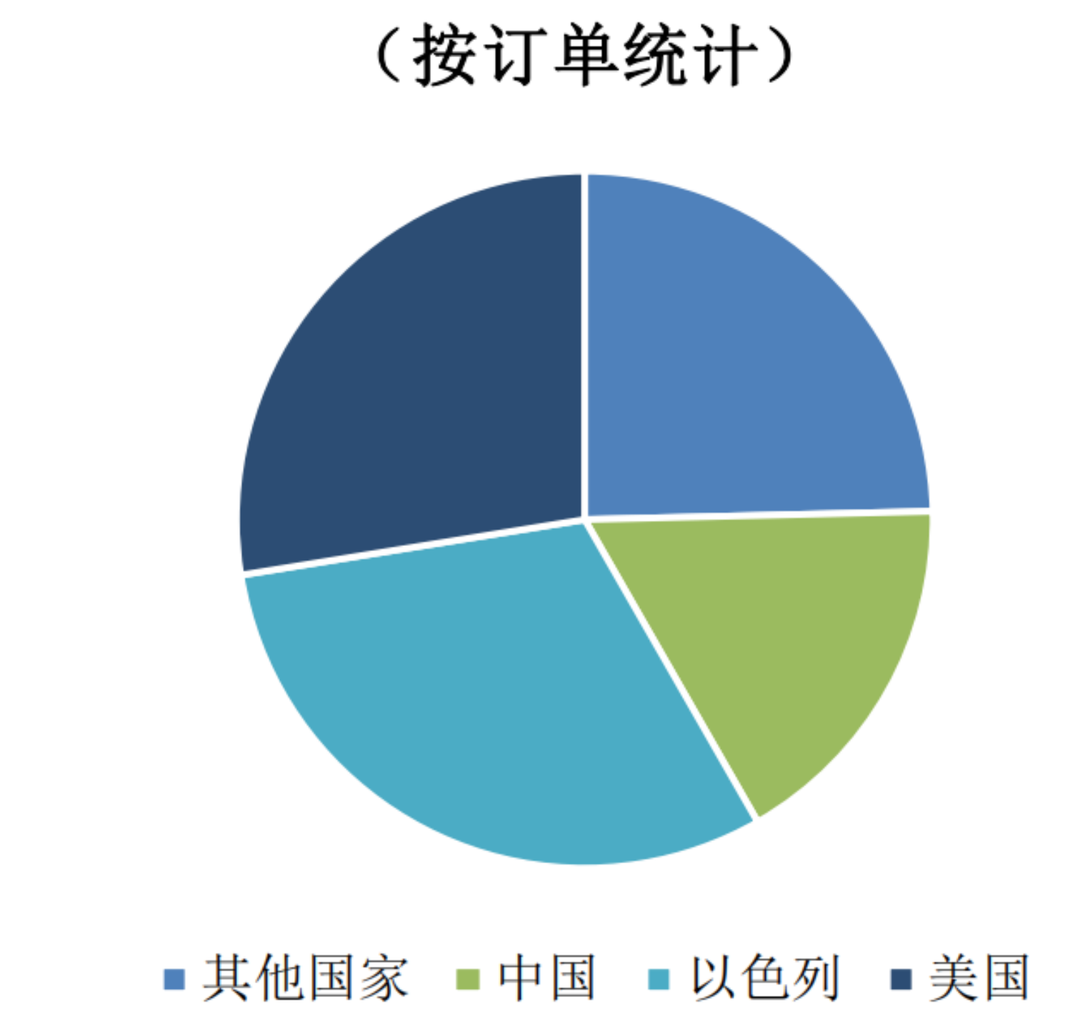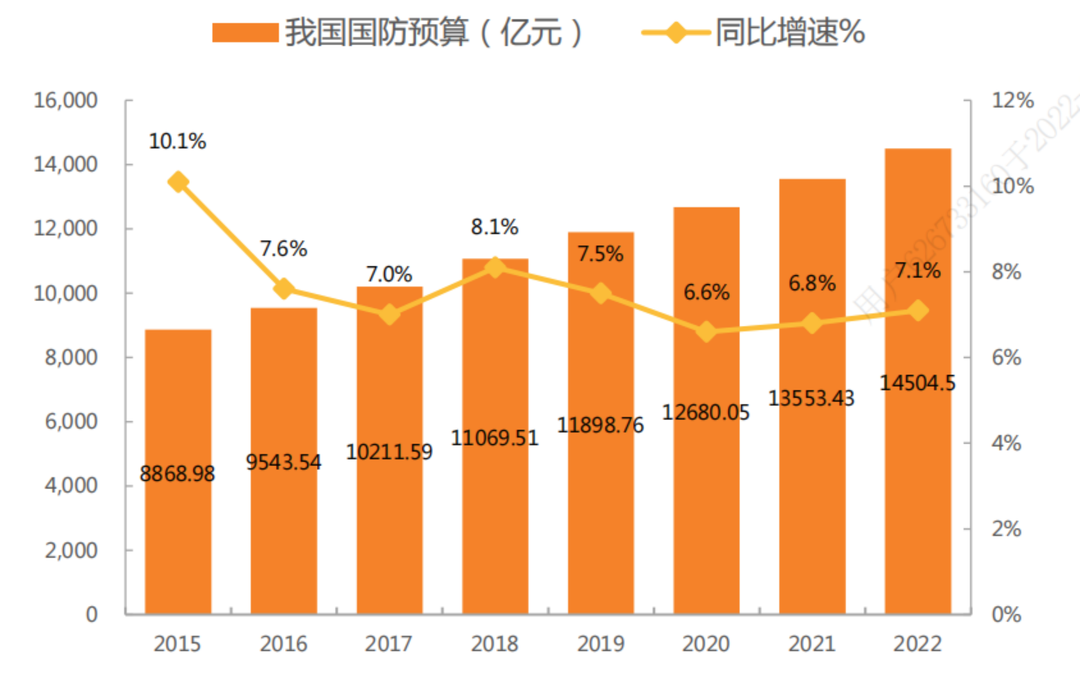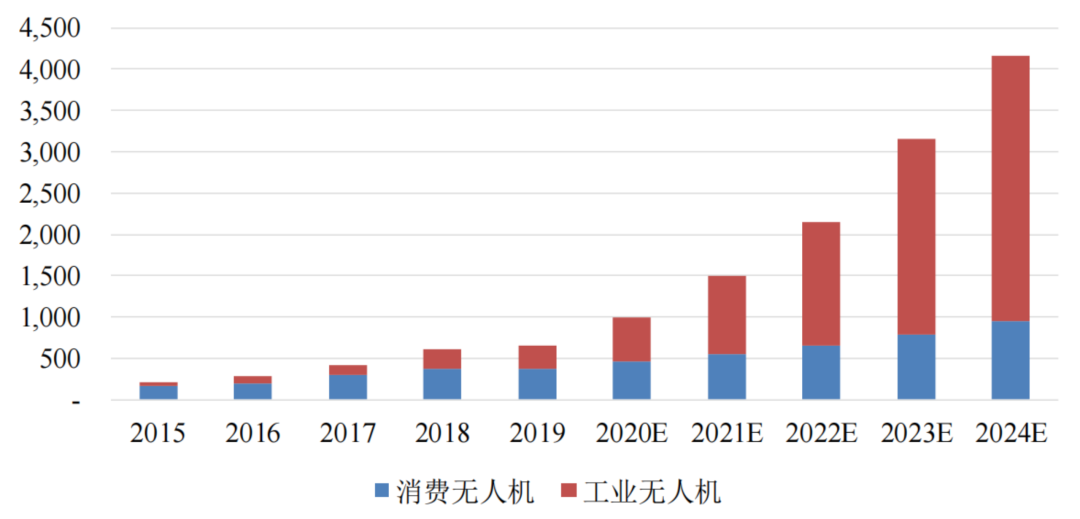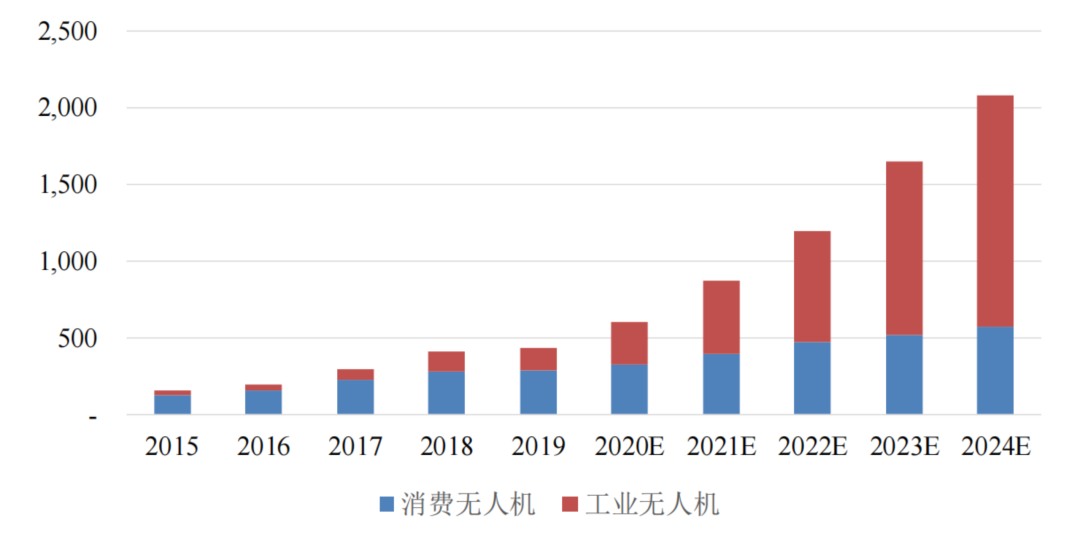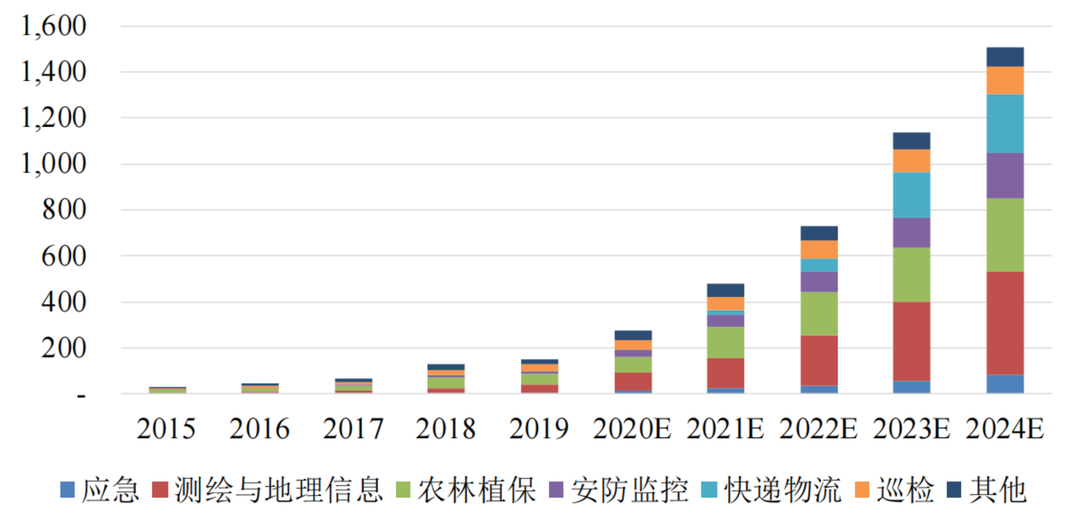The UAV consists of a flight platform, a power unit + four major systems, of which the flight control system is the core. Military drones: The global output value is expected to reach US$14.798 billion by 2028, with a compound growth rate of about 5.36%. my country's military UAV equipment procurement scale in 2022 is about 8.7 billion yuan, and the future market space for foreign military trade is considered to be about 30 billion yuan. Civil drones: By 2024, the global civil drone market will grow to RMB 415.727 billion, with a compound annual growth rate of 43.03% from 2015 to 2024. Among them, it is estimated that by 2024, the market size of industrial drones will far exceed that of consumer drones, reaching 320.82 billion yuan, accounting for 77% of the global civilian drone market from 25% in 2015. The average compound growth rate reached 57.55%. In 2024, the market size of China's civil drones will be about 200 billion yuan, of which industrial drones will be about 150 billion yuan. |UAV overview: flight platform, power unit + four major systems A UAV is an aircraft that does not carry an operator, is powered by power, is reusable, flies aerodynamically, can carry a payload, and completes a designated mission under remote control or autonomous planning. A typical UAV system consists of a flight platform, a power unit, an avionics system, a mission load system, a ground system, and an integrated support system. The specific composition is shown in the following figure: |Introduction to core components Aircraft platform: The flight platform of UAV is mainly divided into fixed-wing UAV platform and rotary-wing UAV platform . The fixed-wing UAV platform generates forward thrust by the power unit, which in turn generates lift by the fixed wings on the body. In contrast to the fixed wing, the rotary-wing UAV platform obtains lift by the reaction of the relative motion of one or more rotors and the air. Among them, the UAV platform with three or more rotor axes is called multi-axis unmanned aerial vehicle. machine platform. Power system: The parameters such as the flight speed and flight height of the UAV are directly related to the power system. UAVs for different purposes have different requirements for power units. For example, piston type is suitable for low-speed and low-altitude small UAVs; for target drones, suicide drones or missiles, the thrust-to-weight ratio is required to be high but the service life can be short. Generally, turbojets are used. type engine. Flight control system: The flight control system is the "nerve center" of the UAV and one of the core technologies. The flight control system generally includes three major parts: sensors, airborne computers and servo actuation equipment. The functions realized mainly include UAV attitude stabilization and control, UAV mission equipment management and emergency control. |UAV classification (by application) Generally speaking, UAVs can be divided into two categories: military UAVs and civilian UAVs, of which civilian UAVs are generally divided into consumer UAVs and industrial UAVs. |Military UAV: Gradually realize the leap from auxiliary combat means to basic combat means The development of global military UAVs has roughly gone through the following stages: In the 1920s and 1960s, UAVs were mainly used as target drones, which was the initial stage of the development of UAVs; in the 1960s and 1980s, unmanned reconnaissance aircraft and electronic UAVs emerged on the battlefield. Begin to enter the practical stage. Since the 1990s, UAVs have been fully applied in modern high-tech local wars, and UAVs are in the stage of rapid rise and vigorous development. UAV research in my country started relatively late, starting in the late 1950s. Overall, my country's UAV design and manufacturing technology has reached the world's advanced level. |Military UAVs: Global Ten Billion Dollar Market The annual output value (including procurement) of global military drones is expected to reach US$14.798 billion by 2028, with a compound growth rate of about 5.36% in annual output value (including procurement). Since there are many countries that have demand for UAV equipment, there are currently few countries in the world that have the ability to independently produce high-performance military UAVs. Therefore, compared with traditional weapons and equipment, the global military trade market for UAVs is more active. At present, the main exporting countries in the field of global UAS arms trade are Israel, China and the United States. From 2010 to 2020, Israel has the largest export share in the UAV military trade market, accounting for about 31% of the military trade market, the US market share is about 28%, and the Chinese market share is about 17%. A total of about 25%. The main models of China's UAV exports are the "Wing Loong" and "Rainbow" series of UAVs. |Military UAV: my country's market of about tens of billions of dollars The accelerated investment in defense and military expenditure is the basis for the development of the military industry. In recent years, the growth rate of my country's total defense expenditure budget has remained between 6.5% and 10%. In 2022, my country's military budget will reach 1,450.45 billion yuan, a year-on-year increase of 7.1%. Assuming that the proportion of UAV procurement in China is the same as that of the United States in the military budget (the proportion of UAV equipment procurement in the United States has reached 0.6% in 2019, and the upward trend is obvious), then the scale of China's military UAV equipment procurement in 2022 About 8.7 billion yuan. At the same time, my country is in the process of leap-forward equipment development during the "14th Five-Year Plan", and the scale of drone procurement is expected to increase rapidly in the next few years. In terms of military trade, China accounts for about 17% of the global military trade market. Based on the size of the global drone market, it is estimated that the market will be about 2 billion US dollars in 2022 and about 3 billion US dollars in 2025. |Development Trend of Military UAV ① Become the main battle equipment of advanced air combat forces and a key component of systematic and intelligent operations. Advanced UAV systems such as high-altitude, high-speed, stealth, and long-endurance will show outstanding strategic penetration capabilities and long-lasting combat capabilities in future high-risk areas and high-intensity confrontation combat environments; manned and unmanned coordinated, distributed air operations , cluster operations, etc. will become important forms of future air operations, and high-performance UAV systems will become the top priority of future intelligent air power construction. ②Comprehensive integration. UAVs need to face increasingly complex modern warfare methods and environments, and only relying on a single system of reconnaissance, surveillance and attack can not give full play to their due combat effectiveness in modern warfare. The UAV system must give full play to the advantages of various functions and levels of UAVs, and combine with other combat systems to form an organic whole that can cooperate, complement each other and cooperate with each other, in order to achieve the best overall combat effect. ③ Highly intelligent. A series of tasks from take-off to landing of UAVs all rely on operators and ground control stations, and the coordination requirements between UAVs and operators are more complex than that of manned aircraft. The delay of remote control and the non-intuitive operation mode determine the unmanned The response efficiency of the aircraft to the combat situation is lower than that of the manned aircraft. In addition, the current drones are mainly controlled manually, and the operation may be affected by electromagnetic attacks. If the operator makes a temporary misjudgment, it will also bring catastrophic consequences. To this end, UAVs must have a high level of automation and intelligence, and can independently judge emergency strategies for battlefield variables. Therefore, a high degree of automation and intelligence, including autonomous flight, intelligent mission planning, and intelligent weapons, is unmanned. important trends in machine development. In addition, given that UAVs have a large amount of flight data that can be used for analysis and targeted optimization of UAV autonomous intelligence, the intelligent autonomy of UAVs combined with big data applications will be greatly enhanced in the future. ④ Develop towards stealth, high altitude, high speed and long endurance. Stealth UAV is the result of the combination of modern stealth technology and UAV technology. In the future air combat, stealth UAV will become a typical representative of high-performance air defense weapons, and greatly reduce the destruction rate of UAVs and improve military Human-machine battlefield operation space, reducing the cost of UAV combat. In addition, in order to improve the continuous reconnaissance and combat capabilities of military UAVs, and to obtain the most accurate and comprehensive enemy intelligence during reconnaissance, improving endurance, flight speed and flight altitude has also become a research topic for UAV systems around the world. One of the key development directions. High altitude, high speed and long endurance can not only ensure the safe operation of UAVs, but also expand the combat radius of UAVs and improve work efficiency, so as to further play the role of military UAVs in battlefield reconnaissance, surveillance and attack. |Civil drones: the global market is about 400 billion, and the future will be dominated by industrial drones The global civilian drone market will grow from RMB 21.45 billion in 2015 to RMB 65.738 billion in 2019. In terms of type composition, consumer drones have always occupied a large market space for civilian drones in the past few years, but with the expansion of drones in industrial application scenarios, industrial drones will become the development of civil drones in the future. Hot spots, the market size will grow rapidly. By 2024, the global civilian drone market will grow to RMB 415.727 billion, with a compound annual growth rate of 43.03% from 2015 to 2024. In addition, the growth rate of industrial drones is expected to significantly exceed that of consumer drones and gradually become a major component of the civilian drone market. It is estimated that the industrial drone market will reach 320.82 billion yuan by 2024, accounting for 77% of the global civilian drone market from 25% in 2015, and the compound annual growth rate from 2015 to 2024 will reach 57.55% . |Civilian UAV: my country's Hundred Billion Market From 2015 to 2019, the size of China's drone market has grown from 15.551 billion yuan to 43.512 billion yuan. According to Frost & Sullivan's forecast, China's civil drone market will reach 207.559 billion yuan in 2024. With the continuous expansion of application scenarios, industrial drones have achieved rapid development. It is expected that by 2021, the scale of China's industrial drone market will surpass that of consumer drones for the first time, becoming the main market in the civilian drone segment. By 2024, the scale of my country's industrial drone market will increase to 150.785 billion yuan, accounting for about 73% of China's civil drone market from 19% in 2015, and the compound annual growth rate from 2015 to 2024 will reach 54.52% %. |Development Trend of Civilian UAV ①Multi-task load The mission function of the civil UAV system is generally realized by the mission load. If the mission load carried is relatively single, it can only complete a specific function. With the development of social economy and the maturity of the UAV industry, the tasks performed by industrial UAVs show a trend of diversification. Only carrying mission loads such as ordinary small cameras cannot meet their task execution capabilities in surveying and mapping, inspection, and agriculture, forestry and plant protection. Secondly, the mission load weight of the UAV is one of the important factors affecting the endurance time. How to better integrate multiple payloads with UAVs and perform tasks with more economical platforms is the main direction of industry research. ② Miniaturization of mission load The narrow interior space is one of the prominent features of civilian drones. However, with the development of the UAV industry, more and more loads need to be installed in order to perform diversified tasks, which leads to the need to make the load smaller and smaller when the space of the UAV remains unchanged. In the future, with the rapid development of UAV technology, the continuous improvement of mission payload manufacturing technology and technology, and the continuous introduction of new materials, the miniaturization of UAV mission payloads will become one of the important development trends in the field of civilian UAVs. ③Intelligent autonomy Similar to military drones, large industrial drones are often used in harsh and complex work scenarios such as emergency communications and meteorological detection, and are used in diverse terrains including oceans, mountains, and woodlands. A slight delay in manual control may cause collisions. aircraft and other dangerous events. In addition, the country is increasingly concerned about the flight safety of UAVs, so it is very important to track the flight dynamics of UAVs, including flight trajectory, altitude, speed and other information. Autonomous intelligence will improve the operation efficiency of UAVs and further improve the safety performance of UAVs, which is one of the important development directions of large-scale industrial UAVs in the future. ④Management standardization At present, my country's industrial drone management system is gradually being established and improved. The Ministry of Industry and Information Technology, the Civil Aviation Administration and other competent authorities are gradually introducing relevant laws and regulations such as flight standard management, aircraft airworthiness certification management, and market operation management, including civil unmanned aerial vehicles. Exploratory norms including the pilot zone system have been initially established. At the same time, referring to the model of manned-aircraft navigation companies, the operation mode of large-scale UAVs may shift from the current vertical integration mode of direct service provided by UAV development enterprises to the service provided by professional large-scale UAV operation companies, and UAV development enterprises An industrial chain collaboration model that provides technical support for operating companies. In the future, my country's industrial drone management system will surely develop towards perfection and regulation, and the upstream and downstream development models of general aviation and other industrial chains will also become more mature.